Jamesbrittenia tysonii
Jamesbrittenia tysonii (Hiern) Hilliard
Family: Scrophulariaceae
Common names: Karoo jaybee, wild phlox (Eng.) witbergheuningkaroo, witsafraanbos (Afr.)
Introduction
Jamesbrittenia tysonii is an appealing and resilient perennial with pretty, delicate white flowers in spring and summer. This plant requires little maintenance and thrives in a variety of conditions, making it an ideal garden plant.
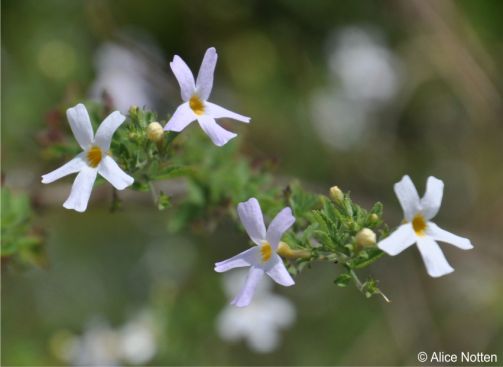
Description
Description
Jamesbrittenia tysonii is an evergreen, moderately fast-growing, upright, perennial shrublet, 300–500 mm high and with a spread of 500 mm. Its stems are slender, slightly woody, the branches delicate yet robust and the leaves are small, ovate to lance-shaped, and arranged oppositely.
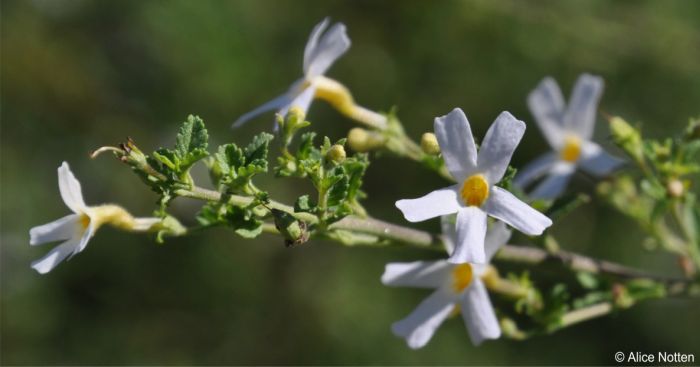
The flowers are funnel-shaped, with a flat, open face formed by five delicate, rounded lobes, and a narrow, cylindrical tube up to 15 mm long. The flowers are a delicate white, highlighted by a vivid cream undertone, the throat is yellow, sometimes with a dark streak at the base of the lobes. They are presented singly in the axils of the leaves, in early spring and summer. The seeds of plants in this family are typically minute and less than or slightly larger than 1 mm in length.
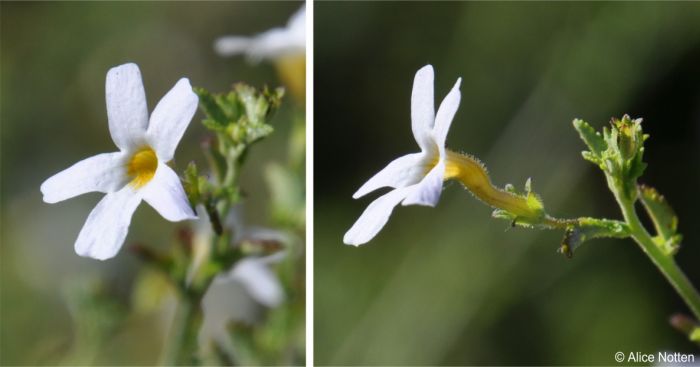
Conservation Status
Status
Jamesbrittenia tysonii is not threatened and is assessed as Least Concern (LC) on the Red List of South African Plants.
Distribution and habitat
Distribution description
This South African plant is native to Eastern Cape, Western Cape, Northern Cape and Free State, growing in the southern part of the centre of South Africa. It thrives in dry shrubland ecosystems with summer rainfall including the Upper Karoo, Sub-Escarpment Grassland, Dry Highveld Grassland and Dwarf Karroid Shrubland Biomes, growing in rocky, sandy, well-drained soils and enjoys full sunlight and open areas. Jamesbrittenia tysonii is drought-tolerant, and grows best in well-drained soils and full sun.
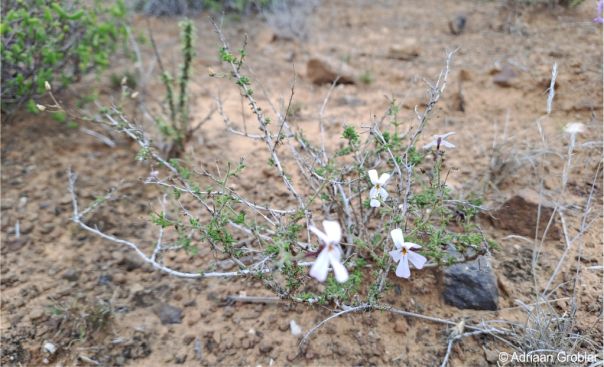
Derivation of name and historical aspects
History
The genus Jamesbrittenia was established by Otto Kuntze in 1891 and named in tribute to James Britten (1846–1924), a British botanist. The type specimen for this plant was collected in 1879 by William Tyson (1851–1920), a Jamaican-born South African botanist, plant collector and school teacher who collected his specimen near Murraysburg. This species was named in 1904 by William Philip Hiern (1839–1925) who was a British mathematician and botanist, he called it Sutera tysonii, after William Tyson. It was moved into the genus Jamesbrittenia in 1992 by Olive Mary Hilliard (1925–2022), a South African botanist.
The Scrophulariaceae (figwort) family comprises 26 families within the order Lamiales, comprising approximately 65 genera and 1 700 species worldwide. While it lacks economically significant crop plants, it is valued for its ornamental species, including Diascia, Nemesia and Buddleja (butterfly bush). Some species, like Verbascum (mullein), have become problematic weeds. This family is characterized by bisexual flowers with tubular, two-lipped corollas (fused petals), and four stamens, typically two shorter than the others. The pistil is usually two-celled and positioned above other floral parts.
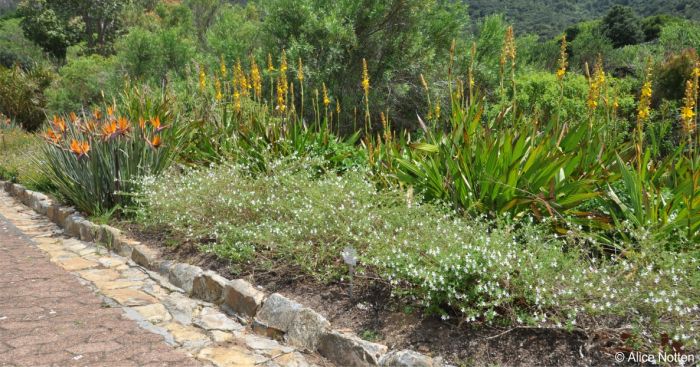
Ecology
Ecology
At this stage, little is known about the ecological adaptations or pollination biology of this species. Plants are palatable to game and stock and are heavily browsed in habitat.
Uses
Use
Even though Jamesbrittenia tysonii may not have medicinal, edible, craft or magical uses, like most plants in the Scrophulariaceae family, it has an aesthetic appeal and adaptability that make it a plant with potential value in the horticulture industry for selective breeding or as a bedding plant, rock garden plant, pot plant or house plant.
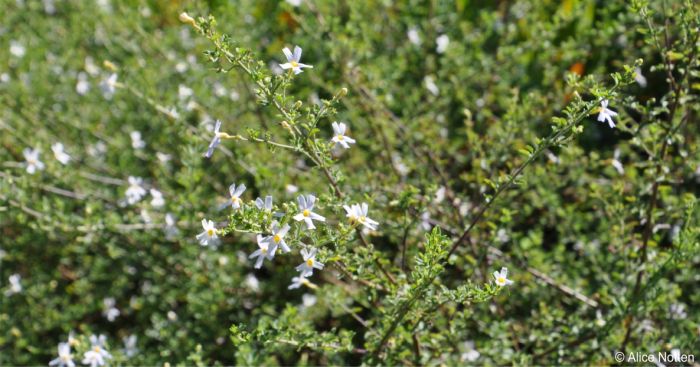
Growing Jamesbrittenia tysonii
Grow
Jamesbrittenia tysonii is relatively easy to propagate from cuttings if you select healthy parent plants. The cuttings should have at least 2-3 nodes. Propagation is done using semi-softwood cuttings or herbaceous cuttings.The rooting medium should be sterile and well-aerated, such as perlite + bark (1:1). Various commonly available rooting hormones were trialled to determine the most effective option for root development. The process began with pre-watering the media before planting the cuttings, followed by additional watering with a seaweed-based growth stimulant. The prepared cuttings were then placed in a mist house to maintain optimal humidity for successful rooting. The results showed a 100% germination rate across all trials and semi-softwood cuttings developed roots after two to three weeks. Cuttings can be taken from early spring.
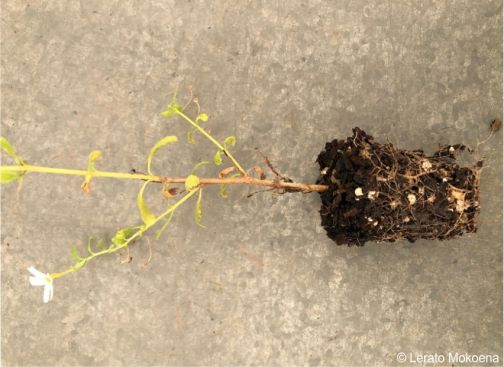
Grow Jamesbrittenia tysonii in well-drained, composted soil, in a sunny position. Water moderately throughout the year. Prune when young to encourage branching but otherwise these plants do not require much pruning. Although frost hardiness has not been tested, judging by its natural habitat it should be able to withstand frost to -5°C. Plants are drought-tolerant when established. This plant does well at Kirstenbosch National Botanical Garden in Cape Town where it has been grown as a bedding plant, and is well-suited to Karoo, Grassland and Highveld gardens, and is suitable for containers.
References
- Arnold, T.H. & de Wet, B.C. 1993. Plants of southern Africa: names and distribution. Memoirs of the Botanical Survey of South Africa No. 62.
- Bredenkamp, C.L. 2019. A flora of the Eastern Cape Province, Volume 2. Strelitzia 41. South African National Biodiversity Institute, Pretoria.
- Britannica. Scrophulariaceae plant family. https://www.britannica.com/plant/Scrophulariaceae. Accessed 2024/12/06.
- Clarke, H. & Charters, M. 2016. The illustrated dictionary of southern African plant names. Flora & Fauna Publications Trust, Jacana, Johannesburg.
- Dlamini, M.D. 2002. Jamesbrittenia grandiflora (Galpin) Hilliard. (Scrophulariaceae). PlantZAfrica. Online. https://pza.sanbi.org/jamesbrittenia-grandiflora.
- GBIF – Global Biodiversity Information Facility. Jamesbrittenia tysonii (Hiern) Hilliard. https://www.gbif.org/species/3740661. Accessed 2025/02/06.
- Grobler, A. 2024-Jun. Observation of Jamesbrittenia tysonii, near Pearston, Eastern Cape. iNaturalist. Online. https://www.inaturalist.org/observations/239387176.
- Harrower, A. 2010. Jamesbrittenia bergae P.Lemmer. (Scrophulariaceae). PlantZAfrica. Online. https://pza.sanbi.org/jamesbrittenia-bergae.
- Natural History Museum (London) Collection Specimens. Holotype specimen for Jamesbrittenia tysonii (Hiern) Hilliard.. https://www.gbif.org/occurrence/1056833712. Accessed via GBIF.org on 06/12/2024.
- Plants of the World Online. Jamesbrittenia tysonii (Hiern) Hilliard. https://powo.science.kew.org/taxon/urn:lsid:ipni.org:names:964722-1. Accessed 2025/02/06.
- Raimondo, D., Von Staden, L., Foden, W., Victor, J.E., Helme, N.A., Turner, R.C., Kamundi, D.A. & Manyama, P.A. (eds) 2009. Red list of South African plants. Strelitzia 25. South African National Biodiversity Institute, Pretoria.
- Retief, E. & Meyer, N.L. 2017. Plants of the Free State inventory and identification guide. Strelitzia 38. South African National Biodiversity Institute, Pretoria.
- WFO The World Flora Online. Jamesbrittenia tysonii (Hiern) Hilliard. https://www.worldfloraonline.org/taxon/wfo-0001259685. Accessed 2025/02/06.
- Wikipedia. Olive Mary Hilliard. https://en.wikipedia.org/wiki/Olive_Mary_Hilliard. Accessed 2025/12/06.
- Wikipedia. William Philip Hiern. https://en.wikipedia.org/wiki/William_Philip_Hiern. Accessed 2025/12/06.
- Xaba, PM. 2018. Jamesbrittenia microphylla (L.f.) Hilliard. (Scrophulariaceae). PlantZAfrica. Online. https://pza.sanbi.org/jamesbrittenia-microphylla.
Credits
Lerato Mokoena
Kirstenbosch National Botanical Garden
February 2025
Acknowledgements: the author thanks her supervisor Phakamani Xaba and Alice Notten for assistance preparing and writing this article, and Adriaan Grobler for making his image of a plant in habitat available via iNaturalist.
Plant Attributes:
Plant Type: Shrub
SA Distribution: Eastern Cape, Free State, Northern Cape, Western Cape
Soil type: Sandy, Loam
Flowering season: Spring, Early Summer, Late Summer
PH: Acid, Neutral
Flower colour: White, Yellow
Aspect: Full Sun
Gardening skill: Easy
Special Features:
Horticultural zones
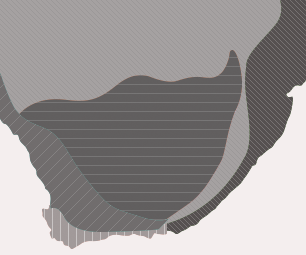










Rate this article
Article well written and informative
Rate this plant
Is this an interesting plant?
Login to add your Comment
Back to topNot registered yet? Click here to register.